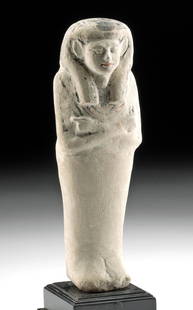
Egyptian Limestone Polychrome Ushabti - Rare Type
Similar Sale History

Recommended Items






Item Details
Description
Ancient Egypt, New Kingdom, Ramesside Period, 19th to 20th Dynasty, ca. 1292 to 1070 BCE. A beautiful, hand-carved limestone ushabti displaying a myriad of fine details. The figure stands in mummiform upon thick legs which gradually expand to wide hips, with elbows projecting from its sides. Red-painted details include a pair of hands holding the symbolic pick and hoe, a large striped pectoral collar which hangs between each shoulder, and a reed basket draped across the back. The visage is composed of almond eyes, a broad nose, and full lips, and the tripartite wig surrounding the yellow-painted face is colored with dark-blue pigment. A single column of incised hieroglyphic text is enclosed with a pair of incised, red-painted bands, and the recessed symbols are brought forth against the yellow ground with black pigment. Typical shabti figures are formed from faience or carved from wood, so a limestone example like this is of exceeding rarity. Custom lucite display stand included. Size: 1.625" W x 5.25" H (4.1 cm x 13.3 cm); 5.625" H (14.3 cm) on included custom stand.
Ushabti dolls are figures shaped like adult male or female mummies wearing traditional Egyptian headdresses. The ancient Egyptians believed that, after they died, their spirits would have to work in the "Field of Reeds" owned by Osiris, the god of the underworld. As a result, they are frequently depicted with arms crossed, typically holding picks and hoes, with baskets on their backs. This meant that the task of agricultural labor was required by all members of society, from workers and scribes to aristocrats and even pharaohs. The wealthier nobility in Egyptian society were able to have ushabti made of faience, though wood was a more economical option for members of lower classes.
While the text on this ushabti has not been translated, it likely follows an abbreviated template from chapter 6 of the Egyptian "Book of the Dead" (literally translated as the "Book of Going Forth by Day"). It pays homage to the "sehedj Osiris" (meaning the "illuminated" Osiris) so that the deity looks kindly and mercifully upon the soul of the deceased when entering his sacred gardens in the afterlife. Shorter inscriptions like the one on this example would simply bear Osiris' name as well as the name and title of the deceased, though longer translations present the deceased as ready and willing to tend to the Field of Reeds when called upon.
Provenance: private East Coast, USA collection
All items legal to buy/sell under U.S. Statute covering cultural patrimony Code 2600, CHAPTER 14, and are guaranteed to be as described or your money back.
A Certificate of Authenticity will accompany all winning bids.
We ship worldwide to most countries and handle all shipping in-house for your convenience.
#137619
Ushabti dolls are figures shaped like adult male or female mummies wearing traditional Egyptian headdresses. The ancient Egyptians believed that, after they died, their spirits would have to work in the "Field of Reeds" owned by Osiris, the god of the underworld. As a result, they are frequently depicted with arms crossed, typically holding picks and hoes, with baskets on their backs. This meant that the task of agricultural labor was required by all members of society, from workers and scribes to aristocrats and even pharaohs. The wealthier nobility in Egyptian society were able to have ushabti made of faience, though wood was a more economical option for members of lower classes.
While the text on this ushabti has not been translated, it likely follows an abbreviated template from chapter 6 of the Egyptian "Book of the Dead" (literally translated as the "Book of Going Forth by Day"). It pays homage to the "sehedj Osiris" (meaning the "illuminated" Osiris) so that the deity looks kindly and mercifully upon the soul of the deceased when entering his sacred gardens in the afterlife. Shorter inscriptions like the one on this example would simply bear Osiris' name as well as the name and title of the deceased, though longer translations present the deceased as ready and willing to tend to the Field of Reeds when called upon.
Provenance: private East Coast, USA collection
All items legal to buy/sell under U.S. Statute covering cultural patrimony Code 2600, CHAPTER 14, and are guaranteed to be as described or your money back.
A Certificate of Authenticity will accompany all winning bids.
We ship worldwide to most countries and handle all shipping in-house for your convenience.
#137619
Condition
Part of legs reattached with small nicks and light adhesive residue along break lines. Surface wear and abrasions commensurate with age, losses to side of head, part of face and wig, and small area of feet, fading and some loss to pigmentation, and fading to some hieroglyphic symbols. Light earthen deposits and great traces of pigmentation throughout. Old inventory label on base of stand.
Buyer's Premium
- 24.5%
Egyptian Limestone Polychrome Ushabti - Rare Type
Estimate $3,500 - $5,000
1 bidder is watching this item.
Get approved to bid.
Shipping & Pickup Options
Item located in Louisville, CO, usSee Policy for Shipping
Payment

Related Searches
TOP

















































